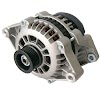Steam Turbine
A steam
turbine is a rotating machine which converts heat energy of steam into
mechanical energy. The super heated steam from the super heater is fed to the
steam into mechanical energy. The super heated steam from the super heater is
fed to the steam turbine which will convert heat energy into mechanical energy.
Steam turbines
are mainly of two types, namely
i) Impulse
turbine
ii) Reaction
turbine
In case of
impulse turbine, the steam expands completely in the stationary nozzles (or
fixed blades), the pressure over the moving blades remains constant. In doing
so, the steam attains a high velocity and impinges against the moving blades. Hence,
impulsive force on the moving blades which sets the rotor rotating.
In case of
reaction turbine, the steam is partially expanded in the stationary nozzles;
the remaining expansion takes place during its flow over the moving blades. The
result is that the momentum of the steam causes a force on the moving blades
which sets the rotor in motion.
After giving
heat energy to turbine, the steam is exhausted to the condenser which condenses
the exhausted steam by means of cold water circulation.
Alternator
An alternator
is coupled on the same shaft of the turbine which will converts mechanical energy
of turbine into electrical energy.
The electrical
energy developed from the alternator is developed from the alternator is
delivered to the bus bars through transformer, circuit breakers and isolators.
Feed water
The steam
coming out from the turbine is condensed and the condensed and the condensate
is fed back to the boiler as feed water.
To reduce
the losses in the closed water circuit, make up water is added.
It is necessary to heat the feed water before feeding it to the boiler for the following reasons.
1. Feed water heater improves the overall efficiency of the plants.
2. The dissolved gases like oxygen and carbon dioxide (co2) are removed.
3. The thermal stresses due to cold water entering to the boiler is eliminated.
4. The quantity of steam produced by the boiler is increased.
In large
modern power plants, if the quantity of make up water required is less, then
evaporators are used. If large quantity of make-up water required, the
impurities are removed through coagulation, sedimentation and chemical
treatment.
Cooling Arrangement
In order to
improve the efficiency of the plant the steam exhausted from the turbine is
condensed by means of a condenser. Water is drawn from a natural source of
supply such as a river, canal or lake and is circulated through the condenser. The
circulating water takes up the heat of the exhausted steam and itself becomes
hot. This hot water coming out from the condenser is discharged at a suitable
location down the river. In case the availability of water from the source of
supply is not assured throughout the year, cooling towers are used. During the
scarcity of water in the river, hot water from the condenser is passed on to
the cooling towers where it is cooled. The cold water from the cooling tower is
reused in the condenser.










0 Comments